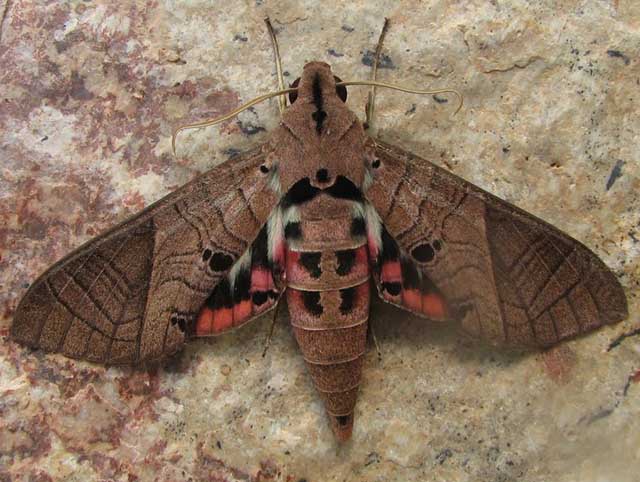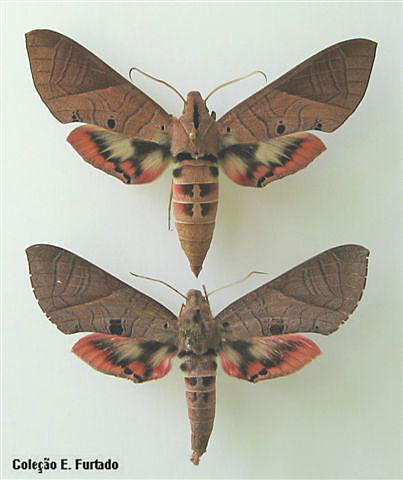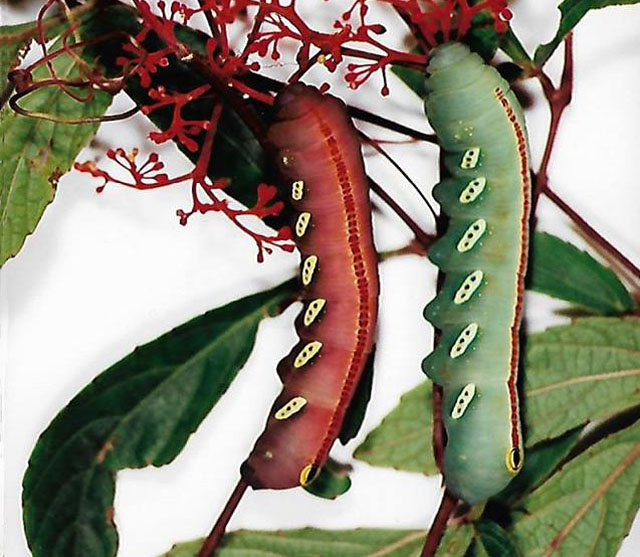Eumorpha adamsi
|
|
Updated as per
AN ANNOTATED CHECKLIST OF THE SPHINGIDAE OF BOLIVIA, October 2007
Updated as per http://www.pybio.org/MACROGLOSSINAE.htm (Paraguay), October 2007
Updated as per personal communication with Eurides Furtado (Mato Grosso)
Updated as per CATE (description, Venezuela, Brazil); February 13, 2011
Updated as per "A Hawk Moths fauna of southern Maranhão state, Brazil, ... "; NEVA: Jahrgang 34 Heft 3 November 2013; via Jean Haxaire; April 5, 2014
Updated as per personal communication with Eurides Furtado (Mato Grosso; April 17, 2018); April 17, 2018
|
Eumorpha adamsi
you-MOR-fuhMad-AMS-eye
(Rothschild & Jordan, 1903)
Phalus

Eumorpha adamsi, Alto Rio Arinos, Diamantino, Mato Grosso, Brazil,
April 17, 2018, courtesy of Eurides Furtado.
This site has been created by Bill Oehlke.
Comments, suggestions and/or additional information are welcomed by Bill.
| TAXONOMY:
Superfamily: Sphingoidea, Dyar, 1902
Family: Sphingidae, Latreille, 1802
Subfamily: Macroglossinae, Harris, 1839
Tribe: Philampelini, Burmeister
Genus: Eumorpha, Hubner, [1807]
Species: adamsi, (Rothschild & Jordan, 1903) |
DISTRIBUTION:
Eumorpha adamsi (forewing length = approx. 40mm) flies in
Venezuela: Caracas;
Brazil: Mato Grosso; southern Maranhao; and
Bolivia: Santa Cruz: Ichilo, Buena Vista;
Paraguay: Concepcion, Amambay.
With its almost uniformly brown forewing, relatively thin lines and convex, forewing outer margin,
it is only similar to Eumorpha translineatus from which it is immediately distinguishable by the bright pink marginal band and tornal patch on the
hindwing. The most pronounced line runs obliquely from midpoint of costa toward the anal angle.

Eumorpha adamsi male: wingspan 78 mm; female: 77 mm,
Reserva Vale da Solidão 14o22’S 56o07’W, 450 m, Mato Grosso, Brazil,
February, courtesy of Eurides Furtado.
FLIGHT TIMES AND PREFERRED FOOD PLANTS:
Eumorpha adamsi adults are on the wing in February and April and probably at other times.
Eumorpha adamsi larvae probably feed upon Vitis. Eurides Furtado reports them on Cissus erosa L. C. Rich. (Vitaceae).

Eumorpha adamsi fifth instars, on Cissus erosa, Mato Grosso, Brazil,
courtesy of Eurides Furtado.
The genus name "Eumorpha" means well-formed.
The species choice of "adamsi" is to honour a peer, collector or friend.
The pronunciation of scientific names is troublesome for many. The "suggestion" at the top of the page is
merely a suggestion. It is based on commonly accepted English pronunciation of Greek names and/or some
fairly well accepted "rules" for latinized scientific names.
The suggested pronunciations, on this page and on other pages, are primarily put forward to assist those who hear with internal ears as they read.
There are many collectors from different countries whose intonations and accents would be different.
The usual practice for names chosen to honour a contemporary, is to say the name, followed by "eye".
ECLOSION, SCENTING AND MATING:
Pupae wiggle to surface just prior to eclosion. Females call at night, and males fly into
the wind to pick up and track the pheromone plume.
EGGS, LARVAE AND PUPAE:
Larval Food Plants
Listed below are primary food plant(s) and alternate food plants. It is hoped that this alphabetical listing followed by the
common name of the foodplant will prove useful. The list is not exhaustive. Experimenting with closely related foodplants is
worthwhile.
Cissus erosa/Vitis erosa ....... | Cissus erosa
|
Return to Philampelini Index
Return to Sphingidae Index
Goto Sphingidae checkists for all countries in North, Central and South America.


